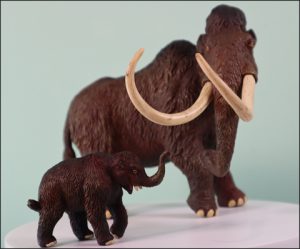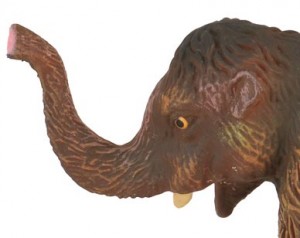Mammoth on the Menu in Palaeolithic Barbecues
New research suggests that ancient barbecues were not for wimps.
In the Summer, when the weather is sunny, many people relish the idea of having a barbecue. Last weekend for example, the air in our garden was filled with the smell of barbecues as a number of our neighbours busily cooked away outdoors. No doubt burgers, sausages and perhaps even chicken drumsticks were on the menu, but had you been around central Europe 29,000 years ago our ancestors would have shown you a BBQ on a very different scale. Excavations from a site of modern human settlement in the Czech Republic has revealed that our ancestors had a taste for Mammoth.
Ancient Barbecues
The site called Pavlov VI is close to the Austrian and Slovak Republic borders and has been excavated by a team of scientists and archaeologists to provide an insight into Palaeolithic settlement. With sediments dated to the Upper Palaeolithic, the site reveals a sophisticated approach to cooking and a well stocked larder with our ancestors feeding on reindeer, horse, bear, wolverine, fox as well as giant elephants. During this period Europe was home to two species of humans, the Neanderthals (Homo neanderthalensis) and our own species (Homo sapiens), although the fossil record indicates that Neanderthals were close to extinction at this point in Earth’s history with just a few pockets of population left in Europe; on the Iberian peninsula.
Studies of other ancient human sites in the region, indicate that smaller animals such as reindeer were the stable meat diet of other tribes, but in this part of the south east of what was to become the Czech Republic; at least one group of humans may have specialised on predating larger animals such as the Woolly Mammoths. The cultural group to which these humans are believed to have belonged is known as eastern Gravettian. Early human cultures are classified according to types of stone tools used and also by symbolic artifacts such as “Venus figures” that are often found by archaeologists. The type of culture exhibited at this site is very reminiscent of Palaeolithic sites found in Russia.
Commenting on the Czech Republic site, Jiri Svoboda (Professor at the University of Brno and Director of the Brno Institute of Archaeology), the project leader on the dig stated:
“It seems that, in contrast to other Upper Palaeolithic societies in Moravia, these people depended heavily on Mammoths”.
Mammoth Remains
The remains of a female mammoth and a mammoth calf were found near a four-foot wide roasting pit. It seems our ancestors dug pits, got fires going in them and then heated round river stones and used the heat from these stones on top of the fire to cook their dinner. This form of cooking is known in many cultures and is still practised in many of the more remote cultures today. It is known as Luau cooking, a Hawaiian term we believe, but this type of cooking is seen in southern Africa with the Bushman and also in Australia with the Aborigines.
The archaeologists found the heating stones still in and around the pit, whether hot rocks were placed inside the mammoth carcass to help cook it is something that can only be speculated about, but this practice is seen in ancient cultures today when cooking large game. Several other pits have been found located near the main roasting pit, it seems that this was a substantial kitchen and food preparation area, probably sheltered by a large tee-pee or other tent like structure.
A Pair of Woolly Mammoth Models (Adult and Calf)

The CollectA Deluxe Woolly Mammoth model in 1:20 scale and the CollectA Prehistoric Life Woolly Mammoth calf. Picture credit: Everything Dinosaur.
Picture credit: Everything Dinosaur
A number of shells have also been recovered from the site, many of them showing signs of decoration. It is not known whether these animals formed an important part of our ancient ancestor’s diets or whether the shells had a spiritualistic significance. In addition, the excavators found a large number of stone tools, including spatulas, blades and saws, just the sort of equipment required when attempting to butcher a Mammoth.
It is possible that the Mammoth hunt was a seasonal activity, with the tribe stalking these huge animals as they migrated to fresh grazing across their lands. The large number of ceramic pieces, decorative pebbles and fragments of fired clay indicate that these people attached a great deal of significance to this particular site. The catching and killing of a Mammoth would have been a very important event to these people, ensuring a plentiful supply of meat and the number of ritualistic finds associated with this particular dig site demonstrate how significant the Mammoth hunt may have been.
Species of Mammoth
Although not the largest species of prehistoric elephant known, the Woolly Mammoth (Mammuthus primigenius) would have been a formidable animal to hunt and kill. As long as a family car and standing over three metres tall at the shoulder, an adult Woolly Mammoth would have weighed nearly 3,000 kilogrammes.
Mammoths have long been associated with human culture and civilisation as demonstrated by the superb cave art at sites such as Lascaux in France. Unfortunately, our modern way of living is damaging these ancient sites.
To read an article on the French cave art: Famous Cave Art under Threat.
We have just introduced a model of very young Woolly Mammoth into our prehistoric animal model collection. The calf is a 1:20 scale model and it has been based on fossilised bones plus of course information obtained from the Siberian frozen Mammoths. Our intention was to add a Woolly Mammoth calf to our range of adult Mammoths, we did not know at the time this new model would represent an item on the menu of early Europeans.
The New Baby Mammoth (Mammoth Calf) Model

A Baby Woolly Mammoth – just like Dima or Lyuba. This is from the CollectA Prehistoric Life model range.
Picture credit: Everything Dinosaur
The Mammoth calf is a welcome addition to the Procon/CollectA range and represents a departure for the manufacturer away from dinosaurs to creating a set of prehistoric animal models.
To view the Mammoth Calf, prehistoric animal figures and dinosaur models in the CollectA Prehistoric Life range: CollectA Age of Dinosaurs Prehistoric Life Models.





Leave A Comment